The Work of Was a Direct Influence on the Conceptual Art Movement.
Eastmerging as an art grade during the 1960s, Conceptual Art investigated the foundations surrounding the concept of what was considered art. From the mid-1960s to the mid-1970s, the Conceptual Art that was created embodied the themes of irony, seriousness, also as stupor in order to be viewed every bit both something and zippo. In doing so, artworks no longer subscribed to the traditional values and aesthetics that underpinned conventional fine art. The Conceptualist Art motion was more interested in understanding the strategies and ideas that went into creating fine art as opposed to the artwork itself.
Table of Contents
- 1 Conceptual Art: An Introduction
- 1.1 Defining the Conceptualist Art Movement
- 1.2 The Forerunners of Conceptual Fine art
- 2 Conceptual Art Characteristics and Influences
- 2.1 Contemporary Influence
- 2.2 Linguistic communication as Fine art
- 2.3 Extremist Positions Within Art
- 3 Notable Conceptual Artists and Their Artworks
- iii.1 Marcel Duchamp (1887-1968)
- 3.two Robert Rauschenberg (1925-2008)
- 3.three Sol LeWitt (1928-2007)
- 3.iv Robert Barry (1936-Present)
- 3.five Lawrence Weiner (1942-Nowadays)
- 3.6 Joseph Kosuth (1945-Present)
- iv The Legacy of Conceptual Fine art
- v Further Reading
- v.1 Conceptual Art (Movements in Modern Art)
- 6 Summary of the Conceptual Art Movement
- 6.1 What Is Conceptual Fine art?
- 6.two What Is an Appropriate Conceptual Art Definition?
- half dozen.3 What Are the Characteristics of Conceptual Art?
- 6.4 Who Is the Forefather of Conceptual Fine art?
Conceptual Art: An Introduction
Known as ane of the most radical and controversial movements inside modernistic and contemporary art, Conceptual Art revolved effectually the idea that the concepts involved within the production of an artwork took precedence over the actual work. Emerging in America during the 1960s, the term Conceptual Art typically refers to art that was made during the mid-1960s and 1970s, with this period paving the manner for other unconventional movements to sally following its peak.
Likewise known as Conceptualism, this movement combined various tendencies of artistic cosmos rather than existing equally one straightforward and coherent move.
Conceptualism took on countless forms and was present in works like art pieces, performances, happenings, and fleeting moments. Works created inside this movement began to question the idea of art itself, equally the previously dominating Modernist motion and its prioritization of the aesthetic beauty within art was rejected.
Despite originating in America, Conceptual Art also reached Latin America, Europe, and the Soviet Union. Within Latin America, artists preferred a more straightforward political response within their artworks. In Europe, Conceptualism was also widely investigated and adult as the countries were very political at that fourth dimension. Finally, in the Soviet Union, Russian artists mixed their own Soviet Socialist Realism with Western Conceptualism and American Pop in order to create a movement where artists were deemed as Moscow Conceptualists.
The Conceptual Art definition was based on the notion that the essence of art was made upward of a piece of work's ideas and concepts, as its chief claim was that an artistic thought could be as the work of art itself. Several artists and art historians disregarded the movement completely and refused to classify any piece of work created within this period equally art. This was because conceptual artists classified expression, skill, aesthetics, and marketability, which were usually standards upon which artwork was evaluated, as substantially irrelevant.
Conceptual artists used whatever materials and forms were bachelor and appropriate to them in the moments they needed them so as to effectively get their ideas and concepts across. The consequence of this were artworks that took on a variety of forms, such equally performance pieces, writings, besides equally the use of everyday objects. Artists investigated the notions of art-as-idea and fine art-as-cognition through incorporating concepts of linguistics, mathematics, and process-oriented thoughts within their works.
Existing as a motility that favored ideas over formal and visual elements, conceptualism as a whole was thought to exist even more than simplified than works such as Andy Warhol's Brillo Boxes (1964), which consisted of a silkscreen re-create of commercial packaging. Thus, Conceptual Fine art was idea to heavily contradict what had previously stood for art.
Conceptual artists best-selling that all art is fundamentally conceptual. In gild to highlight this agreement, many conceptual artists decreased the material presence of their works as much as possible, to the point where artworks were viewed as essentially dematerialized.
The success of conceptualism art was built upon the foundations of previous advanced art movements such every bit the Cubist, Dada, Abstract Expressionism, and Pop movements. A true Conceptualist artist classified themselves at the farthermost end of this progressive and experimental scale, equally they were able to deliberately expand the boundaries of art without any business organisation for what was previously considered as traditional art.
Heavily influenced past the harsh simplicity of the Minimalist movement, Conceptualism rejected the previous conventions of sculpture and paintings that were seen as the cardinal building blocks within creative cosmos.
At its core, fine art produced by conceptual artists did not need to resemble traditional artwork, equally it did non need to take on a physical class at all.
The allure of Conceptual Fine art, which encouraged many artists to partake inside the movement, was the idea that if an creative person began an artwork, the gallery or the audition will in some mode end information technology for them. This was known equally institutional critique, which demonstrated an even bigger shift away from object-based artwork every bit information technology deliberately expressed the importance that society placed on cultural values as a whole.
During the 1960s, prominent New York art critic Clement Greenberg stated that Modern art had reached a peak in its process of reducing and refining the formal nature of artistic mediums. However, by the end of the 1960s, it became clear that Greenberg'due south ideas surrounding the strict boundaries of each medium were no longer deemed correct by artists who wished to experiment. Thus, this newfound view surrounding the possible limitations of mediums allowed Conceptualism to sally successfully.
Conceptualism responded to the commodification of fine art by attempting to subvert galleries equally the location and determining factor of art as well as fine art markets every bit the owners and distributors of art. Influential artists such as Lawrence Weiner stated that once their artworks were viewed, they essentially belonged to the minds of the audiences.
This idea emphasized the core tenet of Conceptualism, which was that the idea was more of import than the actual artwork.
Overall, the bulk of Conceptual Art that was created was cocky-reflexive in nature, as information technology exposed the insecure and self-conscious aspects of artists that were previously hidden. Thus, by using minimal materials and linguistics, a truly Conceptualist artist was able to push button the boundaries and create art that was purely about art.
Defining the Conceptualist Fine art Motility
The term "concept art" was coined by the artist and philosopher Henry Flynt in 1961, when he described his performance pieces as concept artworks, but it was non until the late 1960s that Conceptual Fine art was seen as a definable movement. Flynt intended the term to refer to artworks that were a critique of logic or mathematical insight, just it was not truly applicative until artist Joseph Kosuth properly redefined it to fit within the Conceptualism art move.
Building on the ideas of Kosuth, American artist Sol LeWitt farther defined the terms of conceptual art within his influential 1967 commodity titled "Paragraphs on Conceptual Fine art." His article was one of the most significant writings on Conceptualism, with his definition existence i of the first to occur in impress.
LeWitt's writing presented Conceptual Art as one of the latest innovative movements to emerge, every bit it labeled artworks as both intuitive nonetheless purposeless at the same time.
He stated that the concept exists as the most of import aspect within an artwork, with all of the planning and controlling happening beforehand. This essentially makes the concrete completion of an artwork a perfunctory matter, as the importance lies in the idea of the work.
The Forerunners of Conceptual Art
The origin of Conceptualism dates back to 1917, with French artist Marcel Duchamp believed to be the predecessor of the movement. Duchamp led the way for the conceptual creative person, as he presented them with examples of original works that were conceptual in nature. His most iconic work, Fountain (1917), demonstrated his favored utilize of ready-fabricated objects, every bit he presented a urinal basin that was signed with a pseudonym as a sculpture for inclusion at the yearly exhibition of the Society of Independent Artists in New York.
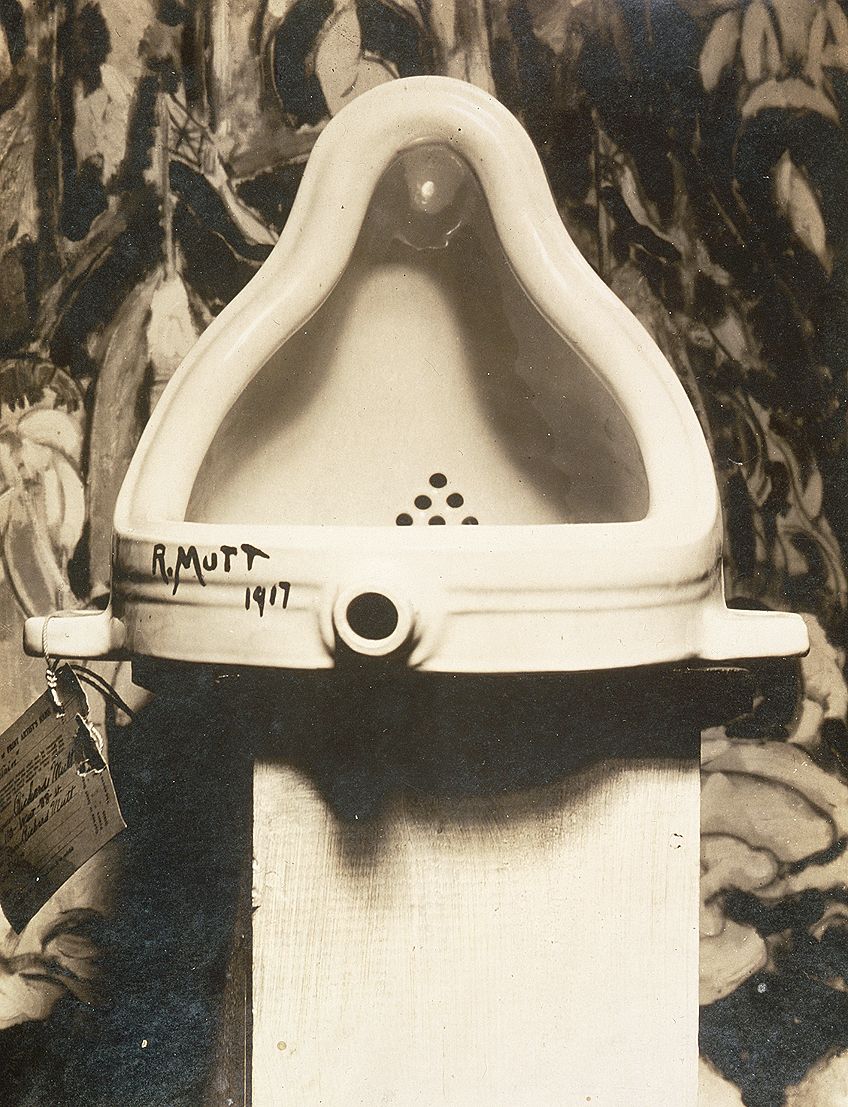 A photograph of Duchamp's Fountain (1917);Marcel Duchamp, Public domain, via Wikimedia Commons
A photograph of Duchamp's Fountain (1917);Marcel Duchamp, Public domain, via Wikimedia Commons
His piece of work was later rejected, as the jury refused to accept his vulgar piece as art, which displayed Duchamp'south questioning of where the limits and confines of fine art essentially lay. His critique of what constituted art upset the very traditional definition of art, as he abandoned dazzler, rarity, and skill within his works in favor of the ready-mades.
The artistic community did not consider ordinary objects such as Duchamp's urinal to exist seen as art, as they were not fabricated with the intent of being an artwork, nor were they special or handmade. Duchamp's revolutionary work with insignificant, commonplace objects sparked outrage in the creative world, which would later lead to the development of Conceptualism as a full-blown art motion. The relevance and theoretical underpinnings within his works were afterwards recognized by Kosuth when he properly defined the move.
Throughout the Conceptual Art motion, the matching of experimental art that was created in relation to what ane'due south personal views of what art was about connected to exist unimportant. As time went on, Conceptual artists managed to effectively redefine the concept of fine art to the point where their efforts became widely accepted every bit art that was worthy of viewing amongst other traditional works.
Conceptual Art Characteristics and Influences
Within the Conceptual Art movement, artists believed that their art was substantially created by the viewer, meaning that the artist and the artwork itself remained irrelevant. Given that the ideas and concepts surrounding an artwork were the central and almost important elements, the aesthetic appeal and materials used inside the piece of work adopted a secondary part within Conceptual Art.
To emphasize the ideas and concepts about an artwork, artists lowered the material presence within their work to an absolute minimum, which was known as dematerialization. This existed as one of the key characteristics of Conceptual Art, as less accent and importance was placed on the materials making up an artwork.
Within Conceptualism, the move rejected the principles of Formalism, as artists did non see the significance in emphasizing trivial formal qualities such as shape, line, and colour. A truly Conceptual creative person believed that ideas surrounding the representational and social aspects of artwork were more interesting to consider than the formal elements used to create a piece of work.
Artists involved with the Conceptual Art movement sought to escape the commercialized world of art by emphasizing that the thought processes and methods of production were the facets within which the true worth of an artwork lay. The fine art forms that they used were deliberately called so that they never produced a finished work that could exist presented to traditional artistic club as a new form of fine art. In doing and then, artworks were non easily bought and sold, as they did not need to be viewed past audiences in an official gallery setting.
In addition to questioning the structures of the fine art earth, a characteristic that many Conceptual artists inserted was their exploration of ideas surrounding strong socio-political themes within the bulk of the piece of work they produced, which in plow reflected their disapproval with society and governmental policies more than comprehensively.
Contemporary Influence
Cartoon heavily on the influence of Marcel Duchamp and his revolutionary works, Conceptualism challenged the boundaries surrounding what could be seen as art or non, as it gave the creative person the ability to decide for themselves if their slice of work could be called an artwork. In doing and then, Conceptualists put forrard the idea that an artwork could fundamentally consist of far-fetched and complex objects and still be accounted art, thus creating a altitude between the job of the creative person from the physical production of the work.
A characteristic way through which Conceptual Art explored the bounds of artwork was by questioning where the realm of art concluded and where utility began. Inspired by the work of Duchamp, artists continued to overturn traditional concepts which had long defined fine art, as they challenged the ideals of what an fine art object should exist fabricated of and how it should await.
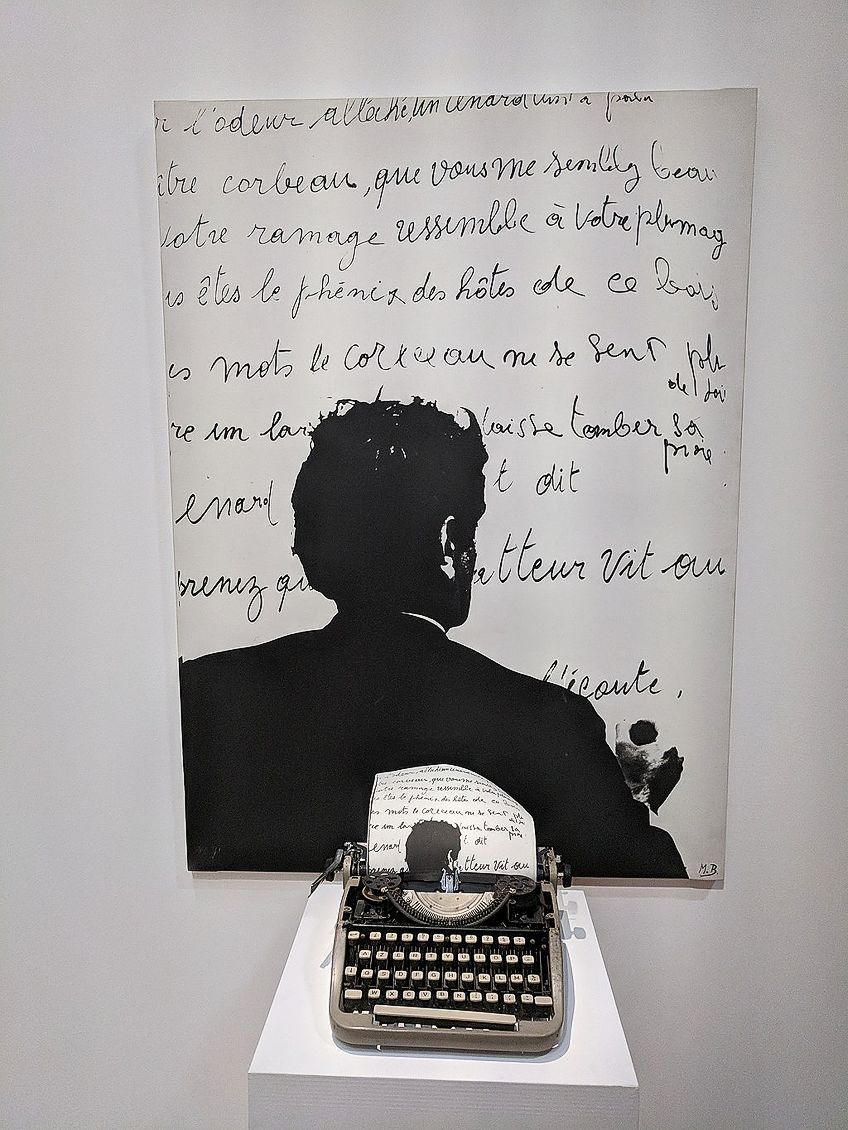 Le Corbeau et le Renard ("The Crow and the Fox") by Marcel Broodthaers (1968); sporst, CC BY 2.0, via Wikimedia Commons
Le Corbeau et le Renard ("The Crow and the Fox") by Marcel Broodthaers (1968); sporst, CC BY 2.0, via Wikimedia Commons
Artworks were viewed equally a process instead of a material object and became something that could not exist seen or understood only by seeing, touching, or hearing it. Therefore, a cardinal characteristic within the fine art production procedure was the thought of activeness, as the process of art-making joined with the final artwork itself to go a truly conceptual activity.
The products of artistic activities were influenced by events such equally the Vietnam War and the development of feminism, which led to a reconciliation between the product of art and its creative and social critiques. Questions almost creative creations were raised, as the very objective of art was questioned. These queries existed as a key characteristic that was ever-present within Conceptual Art.
Ideas like the anti-commodification of art existed as a significant characteristic, every bit the social and political ideas of art were deconstructed and critiqued within the work of Conceptual artists. Concepts existing as the primary medium was perhaps the biggest characteristic with which to identify art made within this move, every bit it took the form of performance art, installation fine art, and digital art.
Linguistic communication equally Art
An of import stardom between Conceptual Art and traditional forms of art was the use of unlike artistic mediums. Language was a central business during the first wave of Conceptualism during the 1960s and early 1970s and was adopted as an exclusive medium by plenty of artists, including Lawrence Weiner, Robert Barry, Edward Ruscha, Joseph Kosuth, and the Fine art and Language collaboration group.
Despite the usage of text within artworks existing as an established method, Conceptual artists began to create artworks using linguistic techniques exclusively. Previously, language was merely presented as one type of visual element aslope a host of others, as it was viewed equally secondary to the importance of the overall limerick. Nevertheless, within Conceptualism, artists discarded this view of linguistic communication and used information technology in favor of brushes and canvases within a piece of work, which allowed language to imply its importance.
Language was used by artists in a diversity of ways. Lawrence Weiner employed language within his works to aid emphasize the thematic content of his works, while artist John Baldessari presented realistic images that he authorized and instructed professional sign-writers to paint.
 Mural (translation:Stone upon Stone upon Fallen Rock) by Lawrence Weiner (1983); AnBuKu, CC BY-SA iv.0, via Wikimedia Commons
Mural (translation:Stone upon Stone upon Fallen Rock) by Lawrence Weiner (1983); AnBuKu, CC BY-SA iv.0, via Wikimedia Commons
Inside Conceptualism, the return to language-based fine art was thought to ascend from the interest stemming from linguistic ideas of pregnant in Anglo-American analytic philosophy and the structuralist and mail-structuralist Continental philosophies during the centre of the twentieth century. This shift to linguistics was thought to strengthen and validate the management that a Conceptual artist took when employing the element of linguistic communication within their works.
Additionally, early Conceptualists were the first generation of artists who completed a university-based degree in fine art training. The subsequent education levels of artists were thought to act as a heavy influence towards the inclusion of linguistics within artworks and to stand in identify of bodily artworks at certain times.
Through adopting language as their sectional and primal medium, Conceptual artists were able to dismiss the remaining authoritative presence that was felt in works towards traditional elements that should be used. Language was able to be applied and experimented with in a variety of ways until it truly became its own form of art as the movement progressed.
Extremist Positions Within Fine art
Some other feature that was present within Conceptual Art was the radicalism that was displayed within artworks. One of the most well-known and extreme examples of Conceptualism was created by creative person Piero Manzoni in 1961, where he presented an artwork titled Merda d'Artista (Creative person'southward Shit). This artwork consisted of 90 tin can cans, with the label on each stating that the cans were each filled with 30 grams of excrement. This left about viewers baffled and referred to the provocation that Manzoni attempted to achieve inside his work.
After the creation of this work, very few Conceptual works were able to combine concept and provocation together in such an farthermost way that it became as constructive as Manzoni'southward work.
Inspired past the seemingly effortless fashion that Manzoni combined high art with excrement, many artists continued to experiment with this idea of incitement throughout the Conceptual Fine art motion. Thus, the concepts of provocation and rebellion became a central characteristic within the works that were fabricated.
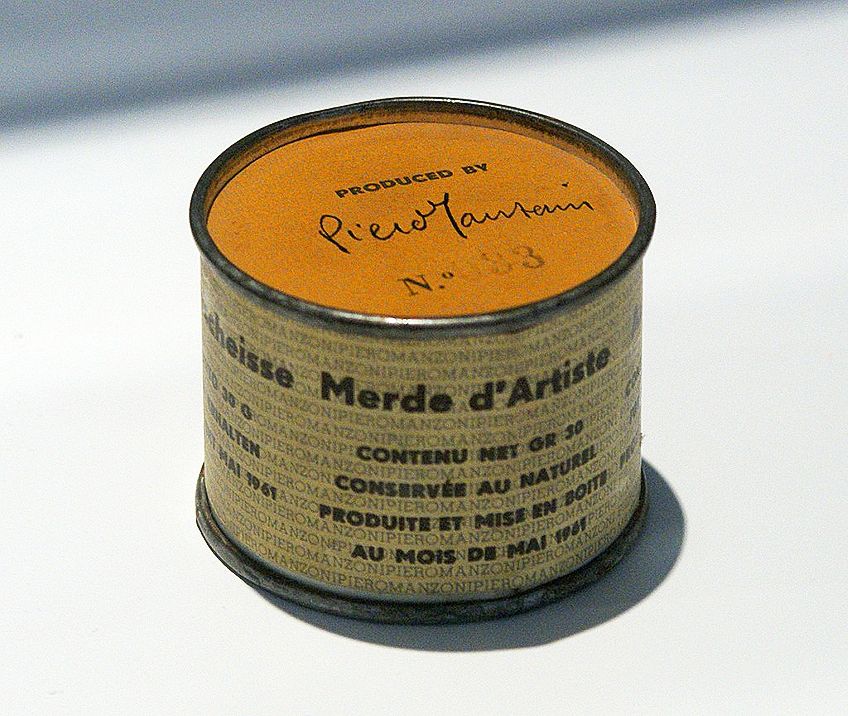 Merda d'artista (Artist's Shit) by Piero Manzoni (1961); Jens Cederskjold, CC BY 3.0, via Wikimedia Commons
Merda d'artista (Artist's Shit) by Piero Manzoni (1961); Jens Cederskjold, CC BY 3.0, via Wikimedia Commons
Notable Conceptual Artists and Their Artworks
Throughout the Conceptual Art movement, many artists produced works of notable importance. A few meaning artists have been included here, along with some of their virtually iconic works inside the Conceptual Fine art movement, as these works accurately demonstrate the core tenets and characteristics that were employed.
Marcel Duchamp (1887-1968)
Known every bit the forefather of Conceptualism, Marcel Duchamp was creating works that were essentially conceptual in nature years before the motion even took off. One of his most iconic works, which is said to be cited as the showtime official Conceptual artwork, is his Fountain sculpture created in 1917.
Duchamp infamously bought a standard urinal from a plumber's shop, signed information technology with the pseudonym "R. Mutt", before submitting information technology every bit a completed artwork for the open up sculpture exhibition of the Lodge of Contained Artists in New York. Despite being office of the selection commission, Duchamp'south artwork was rejected by the jury as they idea information technology to exist unscrupulous and refused to acknowledge information technology as art.
This revolutionary artwork was the showtime of its kind to outwardly reject aesthetic beauty and expertise, as he created a sculpture out of a common, everyday object and demanded information technology to be regarded every bit high fine art. Duchamp'due south Fountain demonstrated a developing curiosity of where the boundaries and limitations of formal fine art lay, as his critique of traditional art began paving the mode for the eventual evolution of Conceptualism.
Robert Rauschenberg (1925-2008)
Some other influential artist within the Conceptual Art movement was Robert Rauschenberg. His most notable work was his Erased de Kooning Drawing, which he created in 1953. Rauschenberg erased an artwork that he acquired from the American artist Willem de Kooning, with his finished artwork featuring an about bare piece of newspaper framed in a simple gold frame.
Rauschenberg created a number of works that explored the limits surrounding the definition of art, with his artworks drawing slap-up inspiration from Marcel Duchamp. Within his Erased de Kooning Cartoon, Rauschenberg intended to detect whether an artwork could be created out of erasure, with the removal of marks being seen equally the artwork itself.
 A photograph of Robert Rauschenberg (1968) at the Stedelijk Museum in Amsterdam;Jac. de Nijs / Anefo, CC BY-SA 3.0, via Wikimedia Eatables
A photograph of Robert Rauschenberg (1968) at the Stedelijk Museum in Amsterdam;Jac. de Nijs / Anefo, CC BY-SA 3.0, via Wikimedia Eatables
Initially, Rauschenberg started out by erasing his ain drawings simply thought that through erasing his own works, he simply created negated drawings that still belonged to him. He later believed that in order for his thought to become a piece of work of art in its ain right, the original work had to vest to someone else. He and so approached de Kooning, an artist who he held in loftier regard, with his idea and asked for a drawing which he could erase.
At outset, de Kooning appeared hesitant just understood the concept that Rauschenberg was exploring, eventually handing over a drawing. When choosing an artwork, de Kooning selected i that he would miss and that would be difficult to erase completely, every bit he believed an added level of difficulty would brand the erasure more profound when completed.
The process proved to exist labor-intensive, as it took Rauschenberg more than a calendar month and about fifteen erasers to complete the artwork. Artist Jasper Johns went on to inscribe a written caption to the piece of work which read: "Erased de Kooning Drawing, Robert Rauschenberg, 1953." The inscription, despite its simplicity, existed as a fundamental chemical element inside this artwork as, without it, the blank piece of newspaper inside a frame would be indecipherable.
When asked about his piece of work, Rauschenberg said that his erasure indicated an ending of Abstract Expressionist art and the idea that art had to be expressive. His erasure was the commemoration of his idea of an absent drawing, as information technology existed in place of traditional elements every bit well as language.
Thus, his piece of work was considered truly Conceptual through its creation. In 2010, the San Francisco Museum of Modern Art used various digital capturing and processing technologies to strengthen some of the leftover traces of the original de Kooning cartoon. This was done to better sympathise what Rauschenberg erased and why he chose to practise so with an artist he supposedly idolized. However, as de Kooning used erasure frequently within his own drawings, some of the traces that were found were actually erased by him before the work passed into Rauschenberg'southward hands.
The resulting image revealed de Kooning's work in progress, as well as the influence that Rauschenberg had on the artwork when he started his erasure. The power of Erased de Kooning Drawing is derived from the appeal of the unseen too as the puzzling determination that Rauschenberg made to erase a de Kooning artwork. Every bit we may never know the respond, Rauschenberg's mysterious piece of work is left open to numerous interpretations.
Sol LeWitt (1928-2007)
Writing one of the first definitions of Conceptual Art to announced in print, American creative person Sol LeWitt stated that the idea or concept of an artwork becomes the concrete machine that essentially produces the work. LeWitt is peradventure best known for his large-scale Conceptual painting artworks which he titled Wall Drawings, which incorporated meticulously bundled colors, designs, shapes, and grids.
These arrangements were drawn in either pencil or paint according to the strict instructions and diagrams that LeWitt produced in order to execute the work correctly. Thus, LeWitt demonstrated that an creative person can follow a guideline of methodical points to produce work that is considered as art, as works do not ever need to originate from a deeper significant. Through this procedure within his artworks, LeWitt shows that his strict ideas behind creating his Wall Drawings are the artworks themselves.
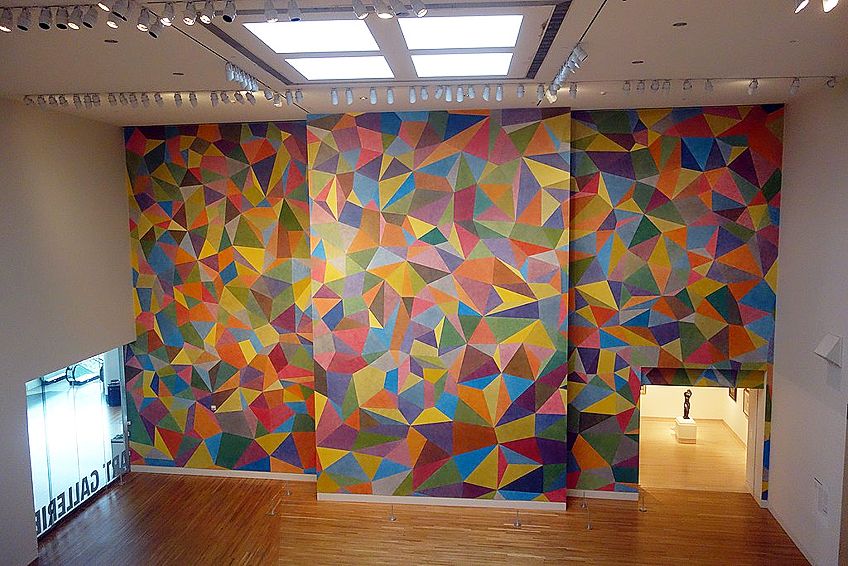 Sol LeWitt's Wall Drawing No. 652, Continuous Forms with Color Acrylic Washes Superimposed (1990) at the Indianapolis Museum of Art;Mike Steele, CC Past 2.0, via Wikimedia Commons
Sol LeWitt's Wall Drawing No. 652, Continuous Forms with Color Acrylic Washes Superimposed (1990) at the Indianapolis Museum of Art;Mike Steele, CC Past 2.0, via Wikimedia Commons
Throughout his career, LeWitt created over 1200 of these drawings, with these works confirming the strong visual vocabulary that he was building. His works displayed modifications on geometric shapes and his drawings eventually adult into structural constructions that were made from materials such as steel, polyurethane, concrete, and stacking cubes.
One of LeWitt's about well-known wall drawings, titled Wall Drawing #16, was one of the beginning that he created in 1969. This work consisted of a network of pencil-drawn lines that were governed past an internal logic that was enforced past LeWitt. The gray lines were drawn 12 inches broad and are shown to intersect horizontally, vertically, and diagonally to the right. However, what makes this work then interesting was that it was the first artwork of LeWitt'due south that he did not construct himself.
Early in his career, LeWitt reached out to others to help create his many Conceptual painting pieces and wall drawings. Wall Drawing #sixteen was completed by James Walker. LeWitt would leave detailed instructions and diagrams for his assistants to follow, who would produce the drawings based on their personal interpretations of his instructions. In allowing others to complete his piece of work, LeWitt addressed the time-consuming nature of his drawings.
Virtually importantly, through choosing others to produce his works, LeWitt demonstrated that the conception of the idea, rather than the physical completion of it, was enough to establish the piece of work equally an fine art piece.
Additionally, LeWitt rejected the traditional importance of an artist's own paw needing to complete an artwork, as he finer decentralized himself from the realization of his piece of work, withal was even so able to take ownership of the finished piece.
Robert Barry (1936-Nowadays)
Another influential artist within the Conceptualism movement is Robert Barry, who adopted language as the main medium within his artworks. 1 of his virtually well-known Conceptual artworks was his All the Things I Know But of Which I Am Not at the Moment Thinking, created in 1969.
Barry created artworks that probed the concept of absence as well as what audiences perceived to the concept of absence to exist, with this artwork speaking straight to his central thought. Displayed every bit a pencil-drawn wall piece, this artwork simply supplied a simple statement that confused audiences who viewed the piece of work. Additionally, Barry gave no farther caption, meaning that audiences had only his intention to rely on when trying to understand the piece of work.
As displayed within Barry'due south iconic artwork, the concepts of pregnant and vagueness conflict with one some other. When producing this slice, Barry claimed the ideas he was non thinking almost as his central thought for this artwork, demonstrating that its physical form was not important. Instead, Barry negotiated the weight of the argument and asserted his use of language to become the artwork itself.
What is interesting to note is that the statement could be spoken, idea, and written differently, yet it is still his artwork no matter the class.
Lawrence Weiner (1942-Present)
Throughout all of the artists mentioned, Lawrence Weiner was one of the most important artists who helped launch the Conceptual Art movement and propel it frontward during the 1960s. Known as a linguistic artist, Weiner'south near well-known works have made apply of language every bit his principal medium.
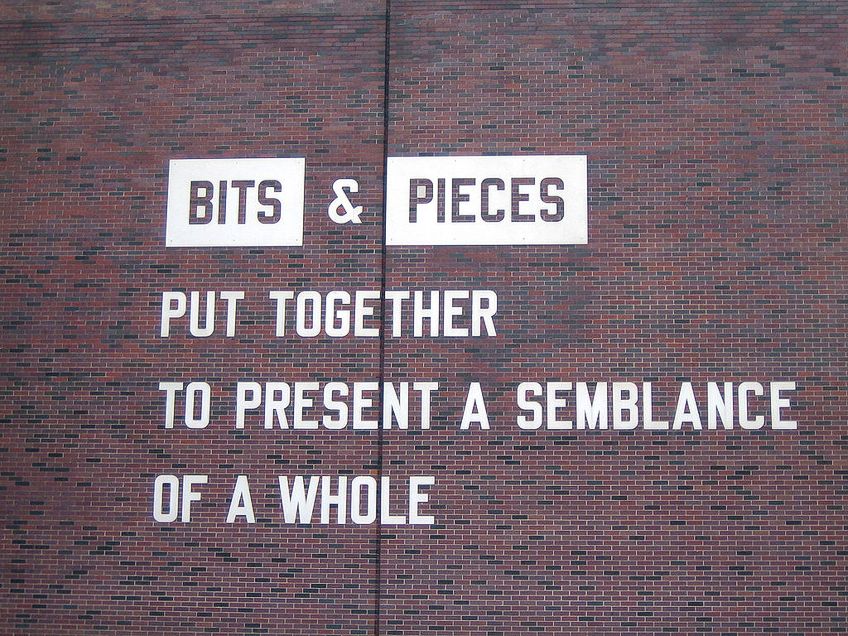 Photo of $.25 & Pieces Put Together to Present a Semblance of a Whole (1991) by Lawrence Weiner, laser-cutting aluminum typography on brick; GearedBull, CC By-SA three.0, via Wikimedia Commons
Photo of $.25 & Pieces Put Together to Present a Semblance of a Whole (1991) by Lawrence Weiner, laser-cutting aluminum typography on brick; GearedBull, CC By-SA three.0, via Wikimedia Commons
Out of his artworks, his nigh well-known is his Proclamation of Intent, created in 1968. This artwork documented his introduction into the Conceptual Art movement, equally the piece of work consisted of iii elementary terms which he believed to describe and dictate the fine art-making process. Using linguistic communication to explain the creation of fine art, Weiner demonstrates that the emphasis of the work lies within its instructions.
Within the statement, Weiner suggested that an artwork could be solely in the form of linguistic communication and thus maintain its conceptual nature, or information technology could be physically synthetic if need exist. Weiner's Announcement of Intent acted equally a guide with which to empathise the rest of his artworks and the Conceptual movement at large, as the statements demonstrated his thinking nearly how art was made and received by others.
Joseph Kosuth (1945-Present)
Existing as one of the pioneers of Conceptualism, Joseph Kosuth effectively defined the term "concept fine art" to appropriately fit into the Conceptual Art movement in his 1969 essay titled "Art later on Philosophy." Within his writing, Kosuth best-selling the significance and theoretical importance of Duchamp's work, as he stated that all fine art created later Duchamp was conceptual in nature, as art could merely exist conceptually. Kosuth stated that an art object existed every bit a mere expression of the idea of art, and after Duchamp'south works, he argued that art's only duty was to then interrogate and define what art essentially was.
Kosuth encouraged a deep contemplation and questioning of what defined traditional fine art, with this theme existence nowadays within the works he created.
His most well-known artwork, titled One and Three Chairs, was created in 1965 and considers the different codes for a single chair. Within the artwork, an bodily chair is situated between a scale image of a chair and a printout lexicon definition of the word "chair." In doing this, Kosuth presented both a visual and a exact lawmaking of a chair, as he used language to define his artwork to the point where it could be accessible to and understood past whatsoever viewer, irrespective of their art knowledge.
Through supplying a real chair with his artwork, Kosuth also gave a code in the linguistic communication of objects, which divers a chair equally an actual wooden object. Kosuth successfully combined a photograph, an object, and an idea to create an artwork that was conceptual in nature, as information technology forced audiences to question what constituted the "chair."
The central thought in Kosuth's work is that audiences are asked which concept fabricated up the real chair. The concrete chair could be viewed as a reproduction of the definition, with the photograph being seen as a reproduction of the actual chair. Thus, audiences were left wondering if a combination of all 3 elements were integral in defining what a chair was, or if the emphasis of a chair was intended to rest on 1 element entirely.
I and Three Chairs rejected a hierarchical departure between an object and a representation of information technology, equally it implied that a Conceptual artwork could consist of either a physical object or a delineation of it in several forms. Kosuth'due south works were conceptual in their cosmos every bit he based them on his innate inquiry into the nature of art, which considered all of the implications and aspects that were involved within the creation of an artwork.
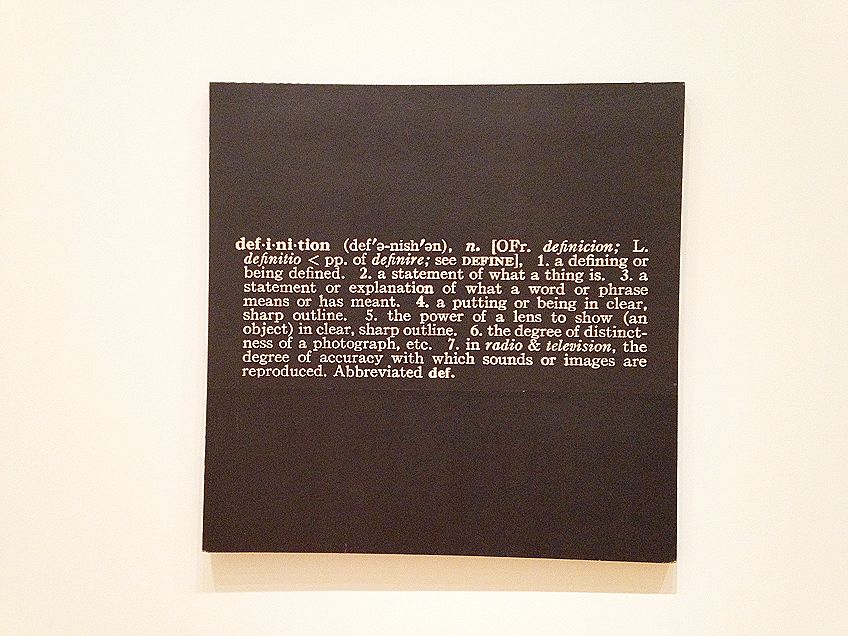 Titled (Art as Idea as Idea) the Word "Definition" (1966-1968) past Joseph Kosuth;Maurizio Pesce from Milan, Italy, CC BY two.0, via Wikimedia Commons
Titled (Art as Idea as Idea) the Word "Definition" (1966-1968) past Joseph Kosuth;Maurizio Pesce from Milan, Italy, CC BY two.0, via Wikimedia Commons
The Legacy of Conceptual Art
Despite the movement's intense introspection, Conceptual Fine art tackled important issues such as time, space, identity, and authorship inside art. Ownership was maybe the most of import topic considered by Conceptual artists, every bit they raised questions about how concepts surrounding art could be bought and belong to those viewing the work.
The themes that were explored within Conceptual Fine art were clearly expressed in the real globe, as they existed as concepts that truly had no correct answer. When considering artists like Sol LeWitt and the work he produced, viewers were left to ponder the question: What is Conceptual Art?
LeWitt answered this by demonstrating that art did not need to be physically created by the artist to be seen in the same light as traditional artworks, as the buying of art had inverse completely. Every bit the movement progressed, it found its way into various other fine art movements such as feminist art and performance fine art. Thus, it is difficult to pinpoint when Conceptual Art truly concluded, every bit other movements continue to borrow some of the core tenets associated with Conceptualism today.
Defining Conceptual Art is a difficult process, equally so many variations exist. Due to its inclination to view all art as essentially conceptual, the Conceptualist Art movement is oftentimes described to include practices and ideas that were not originally related to Conceptualism. Thus, the line betwixt Conceptual Art and other art movements is vague. Despite the fine art motility arising in the 1960s, many artists continue to employ Conceptual Art today.
Farther Reading
Conceptualism is a captivating motility to acquire almost, as different artists introduced dissimilar understandings and definitions for the movement. If you enjoyed reading about Conceptual Fine art and its most influential artists, we take suggested a book that goes into much more than detail to further inform you.
 Lineage (2008-2019) by Lucio Salvatore, an installation series in which fragments of copies of influential artworks are painted on marble; Luciosalvatore, CC Past-SA 4.0, via Wikimedia Commons
Lineage (2008-2019) by Lucio Salvatore, an installation series in which fragments of copies of influential artworks are painted on marble; Luciosalvatore, CC Past-SA 4.0, via Wikimedia Commons
Conceptual Art (Movements in Modern Art)
If you are interested in learning more about Conceptual Art, Paul Wood's book is essential for this. While bookish in tone, this book is written for those who want to read in-depth nearly the movement and sympathise how and why contemporary art exhibitions began to include everything from rubbish to urinals in their display. The book is coherently written, with some complex jargon appearing at times, and provides a comprehensive introduction to the important figures of the Conceptual Art movement

- Learn everything about Conceptual Art
- What was information technology? When was information technology? (Is it all the same around or is it 'history'?)
- Where was it? Who made it?
View on Amazon
Summary of the Conceptual Art Movement
What Is Conceptual Art?
Conceptual Art described artworks that rejected traditional artistic elements such every bit artful ideals, technical construction, and materials used in favor of the idea behind the artwork.
What Is an Appropriate Conceptual Art Definition?
As well referred to every bit Conceptualism, this art movement can be defined as one that prioritized the concepts and ideas involved in constructing the artwork over the physical artwork itself. Thus, after agreement the concept, the completion of an artwork is seen as perfunctory.
What Are the Characteristics of Conceptual Art?
Conceptual Art is characterized past the use of a variety of mediums, as well as an incorporation of ordinary, everyday objects. These are known as ready-mades, which Conceptual artists believed to exist artworks within their own right. Conceptual Art often has no financial value every bit it is instead often used to deliver a powerful message.
Who Is the Forefather of Conceptual Art?
Marcel Duchamp is considered the forefather of Conceptual Art, with his ready-mades possessing the characteristics of Conceptualism before the movement even developed. His most well-known work that was created in 1917 remains Fountain, as he labeled an ordinary urinal as fine art and tried to showroom it. Fountain is thought to be the first conceptual artwork in history.
Source: https://artincontext.org/conceptual-art/